If you've looked towards the east recently, you may be seeing smoke, but don't be alarmed. It isn't another wildfire. It's firefighters conducting prescribed burns in the San Bernardino National Forest.
These so-called pile burns are when vegetation is rounded up, put into piles, dried out and then burned in a controlled way to provide protection to communities adjacent to the forest. Three of them are currently taking place within the forest.
Big Bear Lake: The Lake Williams project (780 piles/78 acres), southeast of the lake, runs along Highway 38 for approximately two miles.
A good first day of pile burning at Lake Williams along Highway 38 near Big Bear Lake. We plan to be back Wednesday. #rxfire pic.twitter.com/hB0jEqFPsq
— San Bernardino National Forest (@SanBernardinoNF) February 21, 2018
Highway 330: Five acres' worth of piles to be burned at the City Creek Fire Station, which is between Running Springs and Highland.
12 piles were completed today at the City Creek Fire Station on Highway 330 between Running Springs and Highland. #rxfire pic.twitter.com/t9x71qQqRq
— San Bernardino National Forest (@SanBernardinoNF) February 21, 2018
Idyllwild: The Pine Cove Fuel Break (2,000 to 3,000 piles/234 acres) is a large project to the west of Idyllwild.
48 acres worth of piles were burned at the Pine Cove Fuel Break today. We plan to continue ignitions on Thursday. #rxfire pic.twitter.com/2zGbDLGZbB
— San Bernardino National Forest (@SanBernardinoNF) February 21, 2018
Marc Stamer is a district ranger of the mountaintop where one of the burns is being conducted within the San Bernardino National Forest. He spoke with A Martinez about why these types of pile burns are necessary and how the cold weather helps.
"You can say it's the proactive approach to helping with wildfires. We know fires are a natural part of our ecosystem, and introducing it in a responsible way with these pile burns is really the best tool we have to manage the landscape...
This winter has been fairly dry for us, so we're actually pretty excited to get some snow and rain across the district and that's enabled us to get out and do some good work."
The cold temperatures and moisture give the firefighters more control over the pile burns, which makes it prime weather to conduct the work.



